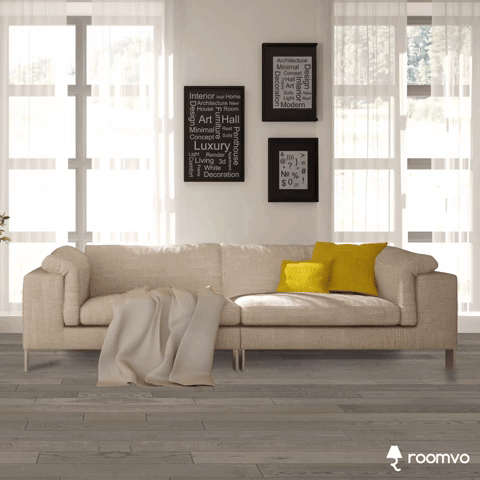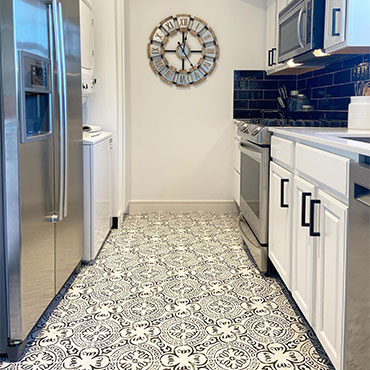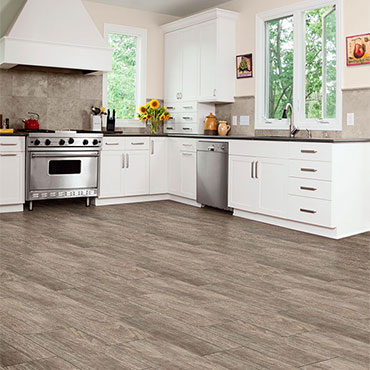
in the Kitchen: A Designer’s Choice for Style and Functionality
The Kitchen: A Blend of Functionality and Style
The kitchen is more than just a functional workspace; it's the heart of the home, where culinary creativity and social connections thrive. As a key design element, flooring must meet the dual demands of practicality and aesthetics. In this space, where spills are inevitable and traffic is constant, choosing the right flooring is critical. Luxury Vinyl Flooring (moisture-prone areas) offers a compelling solution, blending style, durability, and versatility.
This blog post explores whether LVF is the ideal flooring choice for kitchens, evaluating its benefits and limitations across nine critical considerations for interior designers and decorators.
1. Room Purpose
The kitchen is a high-traffic area exposed to frequent spills, stains, and moisture. LVF excels in this environment due to its 100% waterproof nature and ease of maintenance. Its durable wear layer resists scratches and stains, making it ideal for active households and professional-grade kitchens alike. Additionally, LVF's slip-resistant surface enhances safety—a crucial factor in a space where water and oil spills are common.
2. Design Style
Luxury Vinyl Flooring offers unparalleled design versatility, mimicking the look of natural materials like hardwood, stone, and ceramic. Designers can achieve various aesthetics—from modern minimalism to rustic farmhouse—without compromising durability. LVF’s ability to seamlessly blend with cabinetry, countertops, and backsplashes ensures cohesive design schemes, making it a versatile choice for any kitchen style.
3. Durability
Kitchens demand robust materials that can withstand wear and tear. LVF’s multi-layer construction ensures exceptional durability, capable of handling heavy foot traffic, dropped utensils, and shifting furniture. Its protective top layer preserves the floor's pristine appearance, even in high-use kitchens, offering a long-lasting solution that minimizes replacement costs.
4. Moisture Exposure
The kitchen is prone to humidity, spills, and occasional leaks, making moisture resistance a critical factor. LVF’s waterproof properties eliminate concerns about warping, swelling, or staining, unlike natural wood or laminate options. This makes it an excellent choice for ensuring longevity and ease of care in moisture-prone areas.
5. Budget
For designers working within budget constraints, LVF provides a cost-effective alternative to premium materials like hardwood or natural stone. Its ability to replicate high-end aesthetics at a fraction of the cost allows designers to allocate resources to other elements of the project without sacrificing style or quality.
6. Subfloor Condition
LVF’s forgiving nature makes it compatible with a variety of subfloor conditions, including concrete and existing tile. Its click-and-lock or glue-down installation methods simplify the process, reducing labor costs and enabling efficient project timelines—an advantage for both residential and commercial spaces.
7. Eco-Friendliness
Modern LVF products often incorporate sustainable manufacturing practices, including recycled materials and low-VOC finishes. For designers prioritizing eco-conscious choices, LVF aligns with green design goals, supporting projects that emphasize environmental responsibility without compromising quality or design.
8. Soundproofing/Insulation
Kitchens in open-concept homes benefit from flooring that minimizes noise. LVF’s layered construction absorbs sound effectively, reducing the echo of footsteps and dropped items. When paired with underlayment, LVF enhances thermal insulation, creating a quieter and more comfortable space.
9. Health Considerations
LVF’s hypoallergenic surface resists the buildup of allergens like dust and mold, promoting a healthier indoor environment. Its seamless surface is easy to clean, ensuring a hygienic kitchen that meets both aesthetic and practical demands—a significant benefit in homes with children or allergy-sensitive occupants.
Pros and Cons of Luxury Vinyl Flooring for Kitchens
Pros:
- Aesthetic Versatility: Mimics high-end materials like wood and stone.
- Durability: Resists scratches, stains, and wear in high-traffic areas.
- Waterproof: Ideal for moisture-prone environments.
- Budget-Friendly: Affordable alternative to natural materials.
- Comfort: Softer and warmer underfoot than tile or stone.
Cons:
- Environmental Impact: While some products are eco-friendly, others may rely on non-renewable resources.
- Heat Sensitivity: Extended exposure to extreme heat may cause warping.
- Perceived Value: May lack the prestige associated with natural materials like hardwood or marble.
Conclusion
Luxury Vinyl Flooring offers a stylish, durable, and practical solution for kitchens, meeting the needs of both homeowners and design professionals. Its waterproof nature, versatile aesthetics, and budget-friendly pricing make it an excellent choice for creating kitchens that are both functional and visually stunning.
Choose Flooring Product : Laminate Flooring Ideas (18) : Ceramic/Porcelain Ideas (18) : Vinyl/Resilient Ideas (5) : Area Rugs Ideas (2) : Wood Flooring Ideas (130) : LVT/LVP Ideas (28) : Area Rugs Ideas (2)

roomvo
Visualize Flooring In Your Kitchen!
Roomvo makes picking new floors easy. Take advantage of our room visualizer tool to see what your home will look like with any flooring products from our catalog. Just upload your photo to see your room come to life.
 Blog
BlogKitchen - Area Rugs
Should You Use an Area Rug in Your Kitchen? Pros, Cons, and Design Tips
In this engaging blog post, we explore the idea of using in the kitchen, a unique addition that brings warmth, style, and comfort to this high-traffic space. Kitchens, often the heart of the home, require functional yet stylish design elements to balance their dual roles as workspaces and social hubs. We break down the pros and cons of adding area rugs in the kitchen, addressing factors like durability, comfort, and moisture resistance while highlighting how the right rug can elevate a kitchen’s visual appeal.
Each section offers practical guidance tailored to homeowners and consumers, with a friendly tone that simplifies complex considerations like eco-friendliness, budget, and soundproofing. We also provide insights into choosing a rug that aligns with your kitchen's design style, color scheme, and overall theme, ensuring a harmonious and practical addition to the space. Whether you’re looking to define specific zones in an open-plan kitchen or add a cozy touch to your cooking area, this guide helps you make an informed decision on incorporating area rugs into your kitchen’s décor.
Learn More Blog
BlogKitchen - Carpeting
Is Carpeting Right for Your Kitchen? Pros, Cons, and Practical Advice
This blog post by Olivia Wainwright dives into the unconventional choice of using carpeting in the kitchen, exploring whether it’s a practical yet stylish option for homeowners. Given the kitchen's dual role as a functional workspace and social hub, selecting the right flooring impacts everything from aesthetics to usability. aesthetics offers warmth, comfort, and sound absorption but raises concerns about moisture resistance and maintenance.
Each section breaks down essential considerations for kitchen flooring, such as durability, design style, and eco-friendliness, helping homeowners weigh the pros and cons. For those seeking a cozy and unique kitchen aesthetic, this guide provides insights into how carpeting could enhance comfort while addressing potential challenges in upkeep.
Learn More Blog
BlogKitchen - Ceramic Tile
Is Ceramic Tile the Best Kitchen Flooring? Pros, Cons & Design Tips for Homeowners
This blog post dives into the practicality and beauty of kitchen flooring as a kitchen flooring option, explaining why it’s often a top choice for homeowners. The article covers design considerations such as durability, moisture resistance, style versatility, and eco-friendliness, making it a comprehensive guide for those seeking an affordable, stylish, and functional kitchen floor solution.
Learn More Blog
BlogModern Kitchen - Contemporary Rugs
Modern Rugs in the Kitchen: Design Inspiration for Interior Designers
Modern kitchens blend functionality with style,serving as both a workspace and a social hub. This blog post explores the roleof modern Modern in enhancing these spaces, providing interior designers withinsights into their design impact. The article covers key considerations likedurability, moisture resistance, and budget, emphasizing the practicality andaesthetic value rugs bring to modern kitchens.
With their clean lines, bold patterns, and versatile materials, modernrugs offer a unique opportunity to elevate kitchen interiors. The blog providesactionable advice on selecting the right rug, ensuring it aligns with thekitchen’s purpose and modern design elements, while addressing practicalconcerns like maintenance and eco-friendliness.
Learn More
















